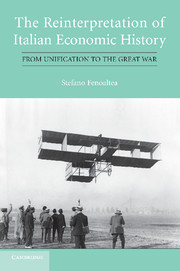Book contents
- Frontmatter
- Contents
- List of Tables
- List of Figures
- Acknowledgments
- Preface
- Introduction
- 1 The Time Series and the Interpretations
- 1A The Measurement of Production Movements
- 2 The Investment Cycle
- 3 The Consumption Cycle and the “Crisis” of the 1880s
- 4 Protection and Migration
- 5 Railways
- 6 North and South
- 6A North and South: A Sectoral Analysis
- 7 The State of Play
- APPENDICES: TARIFFS, TRADE, MIGRATION, AND GROWTH
- Appendix 1 Tariffs and Market Prices
- Appendix 2 The Ricardian Model of Trade
- Appendix 3 Migration and Relative Mobility
- Appendix 4 The Ricardian Model of Growth
- References
- Index
Appendix 4 - The Ricardian Model of Growth
Published online by Cambridge University Press: 05 March 2012
- Frontmatter
- Contents
- List of Tables
- List of Figures
- Acknowledgments
- Preface
- Introduction
- 1 The Time Series and the Interpretations
- 1A The Measurement of Production Movements
- 2 The Investment Cycle
- 3 The Consumption Cycle and the “Crisis” of the 1880s
- 4 Protection and Migration
- 5 Railways
- 6 North and South
- 6A North and South: A Sectoral Analysis
- 7 The State of Play
- APPENDICES: TARIFFS, TRADE, MIGRATION, AND GROWTH
- Appendix 1 Tariffs and Market Prices
- Appendix 2 The Ricardian Model of Trade
- Appendix 3 Migration and Relative Mobility
- Appendix 4 The Ricardian Model of Growth
- References
- Index
Summary
The model of growth
The ricardian model of growth can be illustrated by Figure A4.01. Grain is measured on the vertical axis, labor on the horizontal. The curve illustrates the quantity of grain produced by a given number of agricultural workers. It is a standard production function, characterized by diminishing returns to labor because land is given. As the agricultural labor force increases, therefore, grain output increases but less than proportionately: labor's marginal product (the slope of the curve) decreases, and so does its average product (the slope of the ray from the origin to the relevant point on the curve). The illustrated ray out of the origin is in a sense the inverse of the curve. It illustrates the number of workers “produced” by a given quantity of grain; its slope corresponds to the “subsistence” wage, that is, the wage that keeps the labor force constant. The labor force would increase with a higher wage, and decrease with a lower one; in long-run equilibrium, wages must be at “subsistence,” so defined.
The intersection of the illustrated curves (G3, L3) identifies the equilibrium of a communist society (which distributes the total product equally among the people, and if necessary forces them to work), and also of a society with private property, so long as it is equally distributed (so that the per-capita return to land tops up the less-than-subsistence per-capita return to labor, and everybody again winds up consuming the average product).
- Type
- Chapter
- Information
- The Reinterpretation of Italian Economic HistoryFrom Unification to the Great War, pp. 265 - 272Publisher: Cambridge University PressPrint publication year: 2011



